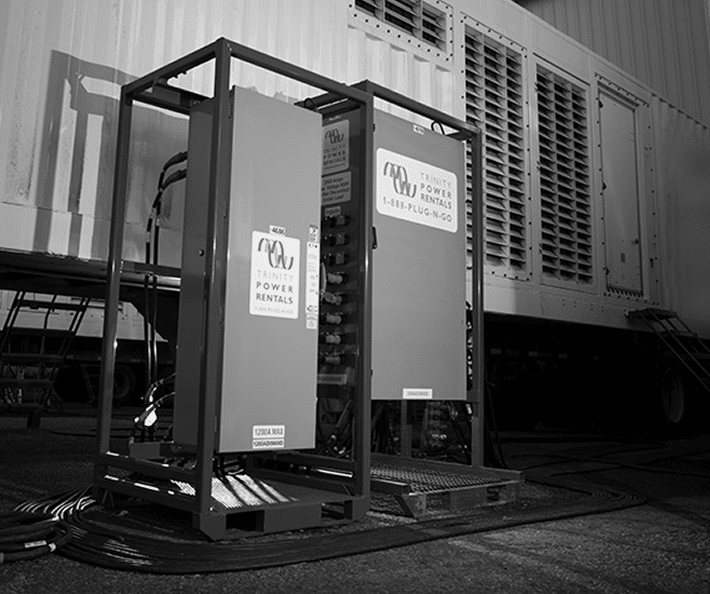- OUR APPROACH
-
COMMITTED TO YOUR SUCCESS
Our approach, developed over decades of experience, is fine-tuned to get the results you want.
We deliver concept-to-completion solutions, designed by temporary power specialists with access to the largest inventory of high-quality power generation and distribution equipment in North America.
-
- Equipment
-
RENTALS
From a wide range of diesel and natural gas generators to transformers, cable, light towers and more, our large rental fleet and extensive vendor network ensure we’ll have the temporary power equipment that your project requires — every time.

-
- Industries
-
INDUSTRIES WE SERVE
For nearly 20 years, we have been at work powering projects across Canada’s industrial sectors.
Select from this sampling of industries to learn how we can put our expertise to work for you.
VIEW ALL- Projects
- About
-
A PROUD HISTORY. A BRIGHT FUTURE.
From our inception in 1998, we have been building our team on a foundation of excellence. Our team members’ passion, expertise and commitment are what have allowed us to grow into a national company with projects across Canada.
Click on the links to learn more about our history, our team or our career opportunities.
- Blog
- Contact
-
A Guide for Class A Consumers
The cost of energy for Ontario businesses has increased dramatically in recent years, and among the top ratepayers are industrial consumers. According to the Association of Major Power Consumers in Ontario (AMPCO), Ontario has the highest industrial electricity rates in North America — and those rates are increasing.
What is a Global Adjustment Charge?
One of the largest components of a business’s energy bill in Ontario is the Global Adjustment (GA) charge — a fee that reflects the difference between the market price and factors such as rates paid to crown/private generation companies and costs for conservation programs and for repairing and replacing infrastructure.
For most consumers, the GA cost is based on monthly consumption. But for consumers who qualify as class A under the Industrial Conservation Initiative (ICI), payments are calculated based on how much energy they use during the previous year’s five peak hours.
This creates opportunities for class A consumers to exercise more control over how much GA they pay. We’ve compiled a list of four key ways your company can take advantage of the ICI to save big on energy costs
Who Qualifies as a Class A Consumer?
Until recently, facilities with an average peak demand greater than 5MW were automatically entered into the program as class A consumers and organizations with peak demands between 3MW and 5MW could choose to opt in.
But as of this January, the eligibility requirements are changing, creating an opportunity for more organizations to take advantage of the ICI program. Now, companies with a peak demand of 1MW or greater (calculated from May 1st, 2016 to April 30th, 2017) can opt into the program. If your company is considering opting in, keep in mind that you must do so by May 31st.
Use Technology to Predict When Peak Hours Will Happen
With GA costs being calculated based on the province’s 5 peak consumption hours, it is critically important to a company’s energy strategy to be able to predict when those peak hours will be. While the IESO provides a peak tracker, which publishes energy consumption data after the fact, it is difficult, from this information alone, to make accurate predictions about future peak hours.
Luckily, a number of options now exist to help organizations predict peak hours, so that they can plan their energy consumption around them.
Our pick is the Sygration Dashboard, by Rodan Energy Services — a straightforward, online dashboard that tracks data from a number of sources in real-time, and provides up-to-the-minute forecasts. The more accurate your data, the more money you’ll be able to save.
Slow Down Production During Peak Hours
Altering production processes presents both the biggest opportunity for savings and the biggest risk to productivity; they require careful planning to be effective. Production curtailment includes strategies such as shifting production to a different time or slowing down production during peak hours.
This might involve reducing the number of machines performing the same task, or breaking up a process to be done in stages before and after the peak period — a strategy that often requires a large storage capacity. Companies that have breaks or slow periods in their production processes are excellent candidates for implementing this kind of strategy.
Use An Alternative Power Generation Method
Provided a facility has the appropriate environmental certifications, running an on-site generator during peak hours is a well-tested and effective peak-shaving method. If your facility already has backup generators, these are likely the best option. If not, a company like Trinity Power can design a cost-effective option, using either temporary or permanent equipment.
This kind of system can be set up to operate automatically, taking over during peak hours and shutting down during off-peak times.
Companies considering this option need to factor in the costs of installing and operating the necessary equipment, as well as maintaining and fueling it. But a vast number of facilities have found that the savings are worth it.
Invest in Demand Response and Management
Another effective GA cost reduction approach is to manage load demand from equipment that isn’t directly related to production.
Since this is a low-risk approach that can be implemented in many facilities, a great deal of demand response technology has been developed that can help. This technology generally involves controllers that automatically reduce the load from various systems and equipment during peak times
A demand response plan might focus on lights and ventilation units that aren’t critical and air conditioning or heating, which can all be turned off or their use reduced. It might also involve rescheduling maintenance and cleaning crews for off-peak hours, to redistribute the energy that they require to operate.
The good news about the ICI is that it is possible for class A consumers to drastically reduce their Global Adjustment costs; this article estimates that simply becoming a class A consumer can reduce energy costs by 20%. Creative planning combined with a carefully executed strategy and help from the experts can save an organization as much as $500,000 per MW.
Related Articles
Subscribe for Access to Exclusive Content
Get insider updates, industry news, special equipment offers, and expert tips—directly to your inbox.
"*" indicates required fields





















